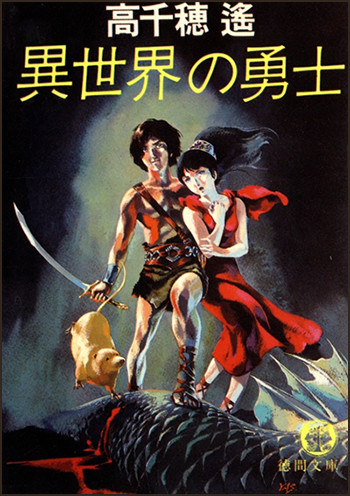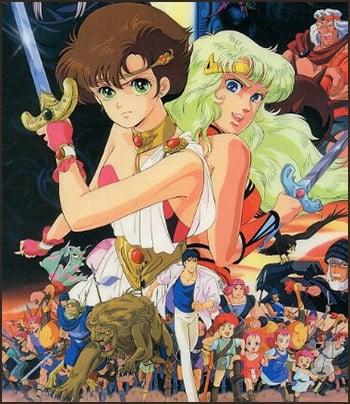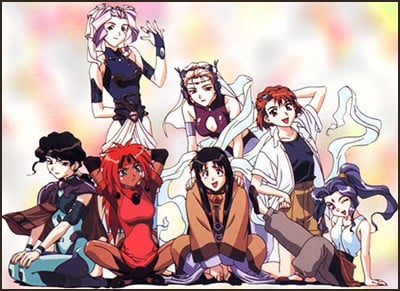The Mike Toole Show
Old School Isekai
by Mike Toole,
Just a couple of weeks ago, I saw a remarkable animated film about the chronicles of a troubled man with a life full of problems, who's whisked away from the world he knows to a new and different parallel universe—one where he must gather his lost confidence, become a hero, join with a party of allies, and defeat the hulking monster that threatens the land. Clearly, this was one of those isekai stories, right? You probably know all about isekai (“another world”), the media genre that's all about going to another world, very often one with some sort of magical or SF element. Japanese animation has been lousy with isekai stories in recent years, from Sword Art Online to Re:Zero to That Time I Got Reincarnated as a Slime. The film I saw wasn't really an isekai story—it was Spider-Man: Into the Spider-Verse, the “hero” is actually a secondary protagonist… basically, I just wanted a fun way to set up talking about isekai anime. You should check out that Spidey movie, it's a good 'un.

Specifically, all this talk about isekai made me wonder about where the genre came from as a Japanese media form, since so many current isekai stories start their lives as literary fiction posted by talented amateurs on sites like Syosetu.com, or “Shosetsuka ni Naro,” (“Let's write a novel”). The whole notion of someone being summoned or teleported to another world is something that, in the west, is pretty handily traced back to children's fantasy fare like Alice in Wonderland, The Wizard of Oz, and of course, John Carter: Warlord of Mars. (Hell, the John Carter series got an unofficial Japanese sequel, 2004's Toshizo Hijikata of Mars… and yes, it really is about the storied Shinsengumi commander turning up in the city of Barsoom!) In Japan, the first notable example of a protagonist being teleported to a fantasy world can be pinned on good old Haruka Takachiho, the Seiun Award-winning creator of the Dirty Pair. He started serializing a story in 1976 called Warrior from Another World. Just check out the cover.

Yep, that's another Takachiho collaboration with artist Yoshikazu Yasuhiko, and if you can read your kanji (I sure can't!) you'll see that the Japanese title even has “isekai” right there. There's nothing too exotic about Warrior from Another World—it's pretty much exactly what's printed on the can, a short fantasy novel about a high-schooler named Ryoji, who's summoned to take up a magic sword and fight against the demon king Gandar Boa. It was collected into a book in 1979—a book that's long out of print. So there's one of the underpinnings of the genre right there. But what was the first isekai anime? Every source I checked, in lockstep, told me it was Aura Battler Dunbine.
But Dunbine came out in 1983, after modern anime had had 20 years to spin its stories—there just had to be something earlier than that, right? I checked pretty closely, but the only real examples I could come up with are the episodes of Time Bokan and Zendaman where they use their wacky animal-themed time machines to travel to other dimensions, rather than back in time—dimensions where they can interact with famous fairytales, natch. That's a real stretch, though—in Tatsunoko's time-skipping adventures, teleporting to another world isn't the real story, it's just a gag used to propel the bigger time-travel story forward. I did find something that I suppose you could say predated Dunbine, and that's the 1982 feature film version of The Wizard of Oz. That would beat Dunbine on a technicality, but Dunbine is the first Japanese isekai story to get the anime treatment, so let's go with that.

Dunbine, an anime TV series by Gundam creator Yoshiyuki Tomino, fits the isekai bill to a tee—in this series, the magic of the Mi Ferario is used to transport Show Zama to the land of Byston Well. Once again, a young man has to take up a magical weapon to defeat an evil overlord. But this time, the weapon is an aura battler, a nifty insectoid mecha suit, and he's actually drafted into the evil overlord's forces before he can get his bearings. This is where the protagonist really won me over; cornered and confused, he listens to his new commander, Bern Bunnings, who testily explains “If you refuse to fight for us, we would compel you to—” “THEN I REFUSE!” Show interrupts, launching a flying kick at his new minder. Show then has his ass kicked, but dang, at least the kid is ready to put up a fight. Even as he and his fellow recruits from Earth, Tod Guinness and Marvel Frozen, are treated lavishly and trained by the military, that sense of angry suspicion never leaves Show's mind, and he ditches them to join the rebellion the first chance he gets.
I've long held that, while Gundam is the big moneymaker, the screenwriter and director Tomino really prefers the world of Byston Well, because he keeps going back there of his own volition. He developed Byston Well novels in parallel with the Dunbine TV series, and kept making them for many years afterwards—and in each iteration, there's always a protagonist who travels from our world to Byston Well. Even infamous bad anime classic Garzey's Wing is an isekai anime! Dunbine doesn't just stand the test of time because of its creator, though—it's a good, sturdy story with mecha design that was really something different for its time. Don't miss the show's conclusion, in which the magic-powered mecha and warships abruptly appear in the real world, and it's an absolute disaster, culminating with Tomino reminding us all that he is very good and efficient at killing off major characters. Ultimately, you can point to Dunbine being the isekai anime template, a story where an ordinary kid is whisked off to an otherworldly conflict, where they must use their own street smarts to prevail.

Dunbine was pretty quickly followed by another isekai anime—1985's Leda - Fantastic Adventure of Yohko. This one-and-done OVA is probably my single favorite isekai anime—between the dreamy Mutsumi Inomata character designs, the endearingly silly-looking cartoon dog that also talks and flies, the pretty and plucky heroine who wears that distinctively 80s side ponytail, and the characters named after foreign words for naughty bits, Leda is a winner all the way. In this story, it's not just about a kid being transported to a magical world where she must wear a fantasy chainmail bikini—Yohko actually brings the source of magic with her, in the form of a cassette tape containing the power of love. It's not the Huey Lewis song, it's a piano sonata she wrote for the boy she likes, and it's a source of incredible power! The story's antagonist, who resembles David Bowie from a parallel world where he took the space wizard schtick a few steps farther instead of transmogrifying into the thin white duke, makes a play for the tape, but Yohko and her new friends and their giant robot aren't gonna give it up without a fight. I'm particularly partial to Leda's dubbed version, which liberally uses the long-outdated slang term “bobby-soxer.” You can still find PVC figures of Yohko, but the video languishes, with a long out-of-print DVD and no Blu-Ray.

The next big isekai anime would hit just one year later—that Super Mario Bros movie! Come on, man, that thing is definitely an isekai story, and it's also part of the isekai Trapped in a Video Game subgenre, which is exactly what Sword Art Online is. What I mean to say is, Sword Art Online is exactly like the 1986 Super Mario anime movie. They should do a crossover. My real answer for “what's the next isekai anime?” would be 1986's Open the Door, another one-and-done film like Leda. This is probably more obscure—it doesn't have a big name like Inomata working on it, and wasn't much of a hit, even in its time. But I've always liked this movie—it uses more sophisticated college kids instead of fresh-faced highschoolers, it once again puts a lady protagonist front n' center, and it's about both vanquishing a villain, and beating her own self-doubt. One big twist—the trio of heroes transported from earth already have ESP. In that sense, Open the Door is both an isekai anime, and an ESPer anime, like Cosmo Police Justy or Kimagure Orange Road. Like Leda, it's long languished in obscurity, with no home video release for over a decade.
At this point, you might be pointing to the 1985 OVA Fire Tripper, and wanting to know why I skipped it. Fire Tripper is a really good OVA, and it's often tagged as an isekai story, but it's not—it's a “time slip” story, more like, say, Urashiman, or creator Rumiko Takahashi's later hit InuYasha. Isekai and time slip stories are often grouped together, but it's important to distinguish whether the story is truly isekai (like Re:Zero), timeslip (like InuYasha), trapped in a video game (like Captain N—er, .hack//SIGN), or all three (like Log Horizon). The next actual isekai anime from this era would probably be Mashin Hero Wataru, by dint of the fact that it's about a normal Japanese 4th grader who's transported to a magical, fantasy-realm version of Japan, where he must use cool mecha weapons and armor to fight the bad guys. I've always loved the color and energy of Wataru, but it never got much of a shot in the west—if you remember the video game Keith Courage in Alpha Zones, then you remember Wataru.

The 90s had a number of quality isekai anime, like Magic Knight Rayearth, Escaflowne, and of course, Those Who Hunt Elves. But my pick for the most consistently enjoyable isekai of that period is El Hazard, a really fun, energetic OVA from AIC, the Tenchi Muyo! people. Here's a story that isn't content to just take a callow young man and dump him into another world— this time, the callow young man, Makoto, is joined by his scheming rival, the rival's equally scheming (but much nicer) sister, and best of all, their alcoholic gym teacher, who discovers that he's been imbued with incredible magical strength, but only when he's sober. The group finds a kingdom in chaos—the realm is threatened by an encroaching insectoid army, rumors of a superweapon, and also they really need our hero Makoto to impersonate their missing princess Fatora. By an astonishing coincidence, he looks just like her, and there you have it, a genuinely compelling action-comedy mix of 1001 Nights, the Prisoner of Zenda, and A Princess of Mars. Some aspects of El Hazard have aged better than others (didn't the princess that our hero Makoto is impersonating have a really grabby 13-year-old consort?) but it's another great example of a short, satisfying series that hits all of its marks. That first El Hazard OAV was so good that they kept making more, even though they didn't need to and probably shouldn't have done.
For me, classic isekai's final boss can only be Fushigi Yuugi, in which ordinary high school girl Miaka Yuuki is transported to a world that resembles ancient China—a world ruled by 4 animal spirits, and in this world, she's destined to be the priestess of one of those spirits, Suzaku. In short order, Miaka is rescued by a handsome ne'er-do-well, summoned to the court of the extremely attractive and refined emperor (who, mysteriously, is just as impressed with Miaka as she is with him), and gradually introduced to a set of seven divine protectors, all who happen to be fun and intriguing young dudes. Did I mention Fushigi Yuugi started life as a shoujo manga?

A few things really set Fushigi Yuugi apart. First of all, the series is frequently comedic-- Miaka is unabashedly silly, constantly cracking jokes and pulling pranks on her new friends. There are hints of action and romance, and when Miaka discovers that the true antagonist of her new situation is actually her best friend, who feels abandoned, the show takes a look at the nature of their friendship. Throughout Fushigi Yuugi's mix of silliness, intrigue, and melodrama, there are suspenseful cutaways to the real world, where family friends realize that Miaka and her pal Yui are actually in danger and race against time to decipher the mysteries of the scrolls that summoned them. This is one of those shows that was a big hit in the 90s, and successfully made the jump from being a cult favorite to a show broadly liked by anime fandom of the time. It was so good that they kept making more Fushigi Yuugi, even though they didn't need to and probably shouldn't have done.
Since that time, there's always been a strong thread of isekai anime—fare like Maze, and Now and Then, Here and There, and Twelve Kingdoms. Even Miyazaki got into the isekai game with Spirited Away. Lately, I've seen some fans express frustration with the genre; too often, it seems like an excuse for a boring, too-cool otaku character to sail through a neat set of stereotypes, with just a single twist (oh look, he has a smartphone! oh hey, they're good at games) to drive the narrative forward. I think the problem there is that we're just waiting for someone to bust it wide open—after all, that's what happened with Sword Art Online. I'm a little tired of the whole Trapped in a Video Game subgenre at this point (plot: the hero is in a video game, so here are the rules of the video game), but I really like the way the media is fed by online fiction-- there's always the chance for the isekai genre to go to another world entirely, so I'm not gonna give up on it. In the meantime, I'm gonna re-watch my favorite isekai show from my childhood in the 80s: that old Dungeons & Dragons cartoon. Hey, it counts!
discuss this in the forum (54 posts) |